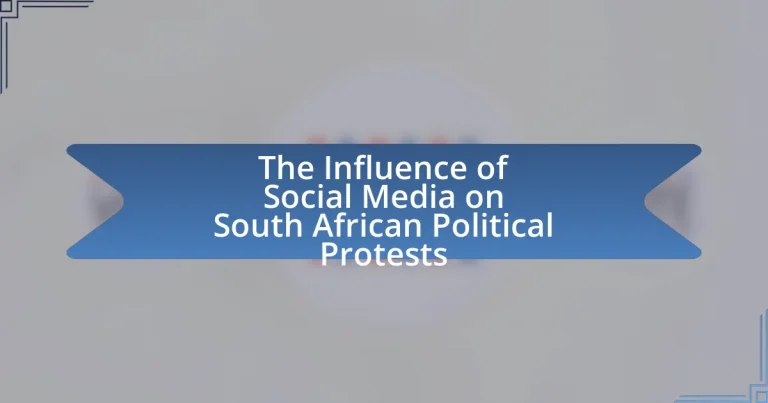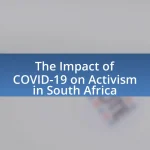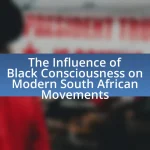The article examines the significant influence of social media on political protests in South Africa, highlighting its role in facilitating rapid communication, mobilization, and awareness among activists. It discusses key movements, such as the #FeesMustFall protests, where platforms like Twitter and Facebook were instrumental in organizing events and amplifying messages. The article also addresses the advantages of social media over traditional media, the challenges activists face, and the impact of government surveillance and misinformation. Furthermore, it explores how social media campaigns shape public perception and influence government policy decisions, ultimately transforming the landscape of political activism in South Africa.
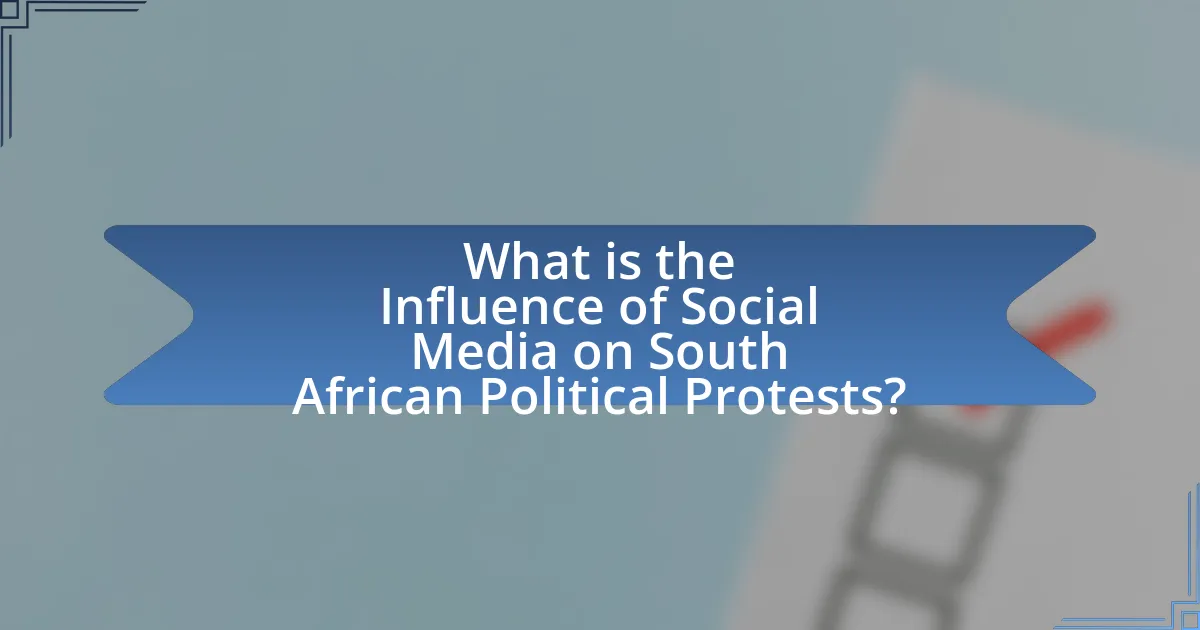
What is the Influence of Social Media on South African Political Protests?
Social media significantly influences South African political protests by facilitating rapid communication and mobilization among activists. Platforms like Twitter and Facebook enable users to share information, organize events, and raise awareness about social issues, leading to increased participation in protests. For instance, during the Fees Must Fall movement in 2015, social media played a crucial role in coordinating student protests against rising tuition fees, resulting in widespread demonstrations across universities. Research indicates that social media not only amplifies voices but also helps in documenting events in real-time, thereby attracting national and international attention to local issues.
How has social media changed the landscape of political protests in South Africa?
Social media has significantly transformed the landscape of political protests in South Africa by enabling rapid mobilization and widespread dissemination of information. Platforms like Twitter and Facebook have facilitated real-time communication, allowing activists to organize protests quickly and efficiently, as seen during the #FeesMustFall movement in 2015, which garnered national attention and participation from thousands of students across various universities. Additionally, social media has provided a space for marginalized voices to be heard, amplifying issues such as corruption and inequality, which has led to increased public engagement and awareness. The ability to share live updates and visuals from protests has also attracted international attention, influencing public opinion and government responses.
What role do platforms like Twitter and Facebook play in mobilizing protests?
Platforms like Twitter and Facebook serve as critical tools for mobilizing protests by facilitating rapid communication and information dissemination among activists. These social media platforms enable users to organize events, share real-time updates, and amplify messages to a broader audience, which is essential for rallying support and increasing participation. For instance, during the #FeesMustFall movement in South Africa, Twitter was instrumental in coordinating protests and spreading awareness about the issues surrounding tuition fees, leading to significant student mobilization and engagement. The ability to reach thousands of users instantly and the viral nature of content on these platforms enhance the visibility of protest movements, making them more effective in garnering public attention and support.
How do hashtags and viral content contribute to protest visibility?
Hashtags and viral content significantly enhance protest visibility by facilitating widespread dissemination of information and mobilizing support. When a hashtag trends on social media platforms, it captures the attention of a larger audience, allowing messages related to the protest to reach individuals beyond the immediate geographic area. For instance, during the #FeesMustFall movement in South Africa, the hashtag not only unified participants but also attracted global media coverage, amplifying the protest’s message and urgency. Viral content, such as videos or images depicting the protest, further engages users, encouraging them to share and participate, which can lead to increased attendance and awareness. This phenomenon is supported by research indicating that social media can increase public engagement in political movements, as seen in studies analyzing the role of digital platforms in contemporary activism.
Why is social media a powerful tool for activists in South Africa?
Social media is a powerful tool for activists in South Africa because it enables rapid communication, mobilization, and awareness-raising among diverse populations. The platform allows activists to disseminate information quickly, organize protests, and engage with supporters, which is crucial in a country with a history of political activism and social movements. For instance, during the Fees Must Fall movement, social media played a pivotal role in coordinating student protests against rising tuition fees, reaching thousands of participants within hours. Additionally, social media provides a space for marginalized voices to be heard, amplifying issues such as inequality and corruption, which are central to South African activism. The ability to share real-time updates and visuals also helps to attract media attention and international support, further enhancing the impact of local movements.
What advantages does social media offer over traditional media for protest movements?
Social media offers several advantages over traditional media for protest movements, primarily in terms of speed, reach, and engagement. Social media platforms enable real-time communication, allowing organizers to disseminate information quickly and mobilize supporters instantly, which is crucial during rapidly evolving situations. For instance, during the #FeesMustFall movement in South Africa, social media facilitated immediate updates and coordination among protesters, significantly enhancing participation and visibility.
Additionally, social media provides a broader reach, as it can connect individuals across geographical boundaries, allowing for a diverse range of voices and perspectives to be heard. This was evident during the 2019 South African protests against gender-based violence, where hashtags like #AmINext gained international attention, amplifying the message beyond local media coverage.
Moreover, social media fosters greater engagement and interaction among participants, enabling them to share personal stories and experiences, which can galvanize support and create a sense of community. This interactive nature contrasts with traditional media, which often presents a one-way communication model, limiting audience involvement. Thus, the advantages of social media in protest movements lie in its ability to facilitate rapid communication, expand reach, and enhance participant engagement.
How does social media facilitate communication among protestors?
Social media facilitates communication among protestors by providing real-time platforms for information sharing and coordination. It enables protestors to disseminate updates, organize events, and mobilize support quickly, which is crucial during dynamic situations like protests. For instance, during the 2015 #FeesMustFall movement in South Africa, platforms like Twitter and Facebook were instrumental in spreading awareness and coordinating actions among students, leading to widespread participation and visibility of the cause. This rapid communication capability is supported by statistics showing that over 80% of South African internet users engage with social media, highlighting its role as a primary communication tool in mobilizing collective action.
What challenges do activists face when using social media for protests?
Activists face several challenges when using social media for protests, including censorship, misinformation, and digital surveillance. Censorship occurs when platforms restrict or remove content related to protests, limiting activists’ ability to communicate effectively. Misinformation can spread rapidly on social media, undermining the credibility of movements and creating confusion among supporters. Digital surveillance by governments or organizations can lead to the identification and targeting of activists, posing risks to their safety and privacy. These challenges hinder the effectiveness of social media as a tool for mobilization and advocacy in South African political protests.
How do government surveillance and censorship impact social media use?
Government surveillance and censorship significantly restrict social media use by creating an environment of fear and self-censorship among users. When individuals know that their online activities are being monitored, they are less likely to express dissenting opinions or engage in discussions about political issues, which is particularly relevant in the context of South African political protests. For instance, a study by the University of Cape Town found that 60% of South African social media users reported altering their online behavior due to concerns about government surveillance. This reduction in open discourse can stifle activism and limit the mobilization of protests, ultimately undermining democratic engagement and the effectiveness of social media as a tool for political change.
What risks do activists encounter when organizing online?
Activists encounter several risks when organizing online, including surveillance, harassment, and misinformation. Surveillance by government agencies or hostile entities can lead to the identification and targeting of activists, as evidenced by reports from organizations like Privacy International, which highlight increased monitoring of online activities in politically sensitive contexts. Harassment can manifest through online threats or doxxing, where personal information is exposed, creating a chilling effect on participation. Additionally, misinformation campaigns can undermine activist efforts by spreading false narratives, as seen in various social media analyses during political movements in South Africa. These risks can significantly impact the safety and effectiveness of online organizing efforts.
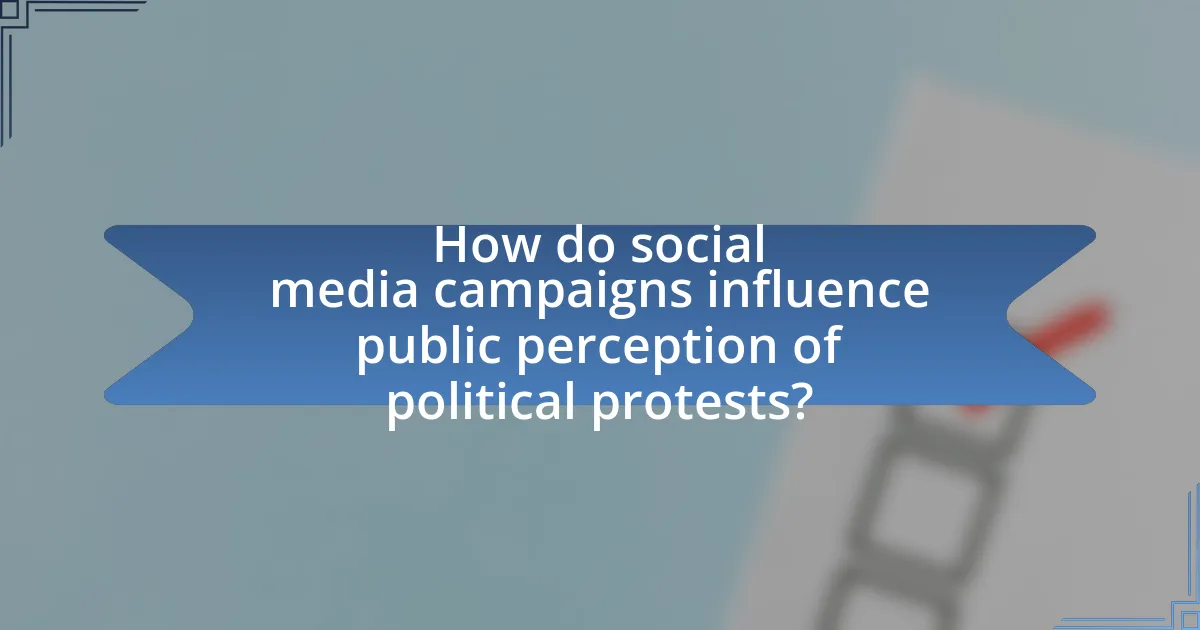
How do social media campaigns influence public perception of political protests?
Social media campaigns significantly shape public perception of political protests by amplifying messages, mobilizing support, and framing narratives. For instance, during the #FeesMustFall movement in South Africa, social media platforms like Twitter and Facebook were instrumental in disseminating information about protests, thereby increasing visibility and engagement among the public. Research indicates that social media can create a sense of community and urgency, leading to higher participation rates in protests. Additionally, the framing of protests through social media can influence how they are perceived, often portraying them as either legitimate expressions of dissent or as disruptive actions, depending on the narrative constructed by campaigners and media outlets. This dual role of social media as both a tool for organization and a platform for narrative control underscores its critical impact on public perception of political protests.
What strategies do activists use to shape narratives on social media?
Activists shape narratives on social media through strategies such as targeted messaging, hashtag campaigns, and visual storytelling. Targeted messaging involves crafting specific content that resonates with particular audiences, enhancing engagement and mobilization. Hashtag campaigns, like #FeesMustFall in South Africa, create a unified conversation around issues, making them more visible and easier to follow. Visual storytelling, including infographics and videos, captures attention and conveys complex information quickly, increasing the likelihood of shares and discussions. These strategies have been effective in raising awareness and influencing public opinion, as evidenced by the significant online engagement during the #BlackLivesMatter movement, which mobilized global support and discussions around racial justice.
How do visual content and storytelling enhance engagement with protest messages?
Visual content and storytelling significantly enhance engagement with protest messages by making them more relatable and emotionally impactful. Research indicates that visuals, such as images and videos, capture attention more effectively than text alone, leading to higher retention and sharing rates on social media platforms. For instance, a study by the Pew Research Center found that posts with images receive 94% more views than those without. Additionally, storytelling creates a narrative that resonates with audiences, fostering empathy and a deeper understanding of the issues at hand. This combination of visual elements and compelling narratives not only amplifies the reach of protest messages but also encourages active participation and solidarity among viewers.
What role do influencers and public figures play in amplifying protest messages?
Influencers and public figures play a crucial role in amplifying protest messages by leveraging their large followings to reach wider audiences. Their ability to create viral content and engage with diverse demographics enhances visibility for social movements, as seen during the #FeesMustFall protests in South Africa, where prominent figures used social media platforms to mobilize support and raise awareness. Research indicates that messages shared by influencers can increase engagement rates significantly, with studies showing that posts from public figures can lead to a 20% increase in participation in protests. This amplification effect is vital for drawing attention to issues and fostering solidarity among supporters.
How does social media affect the response of authorities to protests?
Social media significantly influences the response of authorities to protests by amplifying public awareness and mobilizing support. Authorities often monitor social media platforms to gauge public sentiment and anticipate protest actions, which can lead to preemptive measures such as increased police presence or dialogue with protest organizers. For instance, during the Fees Must Fall movement in South Africa, social media was instrumental in organizing protests and sharing real-time updates, prompting authorities to respond more swiftly and adaptively to the unfolding events. This dynamic illustrates how social media not only shapes the narrative around protests but also compels authorities to react in ways that may prioritize public safety and order.
What tactics do law enforcement agencies use to monitor social media during protests?
Law enforcement agencies use various tactics to monitor social media during protests, including keyword tracking, social media scraping, and the use of specialized software for sentiment analysis. Keyword tracking allows agencies to identify specific terms related to protests, enabling them to gather real-time data on public sentiment and planned activities. Social media scraping involves collecting large amounts of data from platforms like Twitter and Facebook to analyze trends and identify potential threats. Additionally, specialized software can assess the sentiment of posts, helping agencies understand the mood of the crowd and predict possible escalations. These methods have been documented in studies, such as the 2020 report by the International Association of Chiefs of Police, which highlights the increasing reliance on digital surveillance tools for crowd management and public safety during civil unrest.
How do social media campaigns impact government policy decisions?
Social media campaigns significantly influence government policy decisions by amplifying public opinion and mobilizing collective action. For instance, during the #FeesMustFall movement in South Africa, social media platforms were instrumental in organizing protests and disseminating information, which pressured the government to reconsider its stance on tuition fees. Research by the University of Cape Town highlighted that social media not only facilitated rapid communication among activists but also attracted national and international attention, compelling policymakers to respond to the demands of the protesters. This demonstrates that social media serves as a powerful tool for shaping political discourse and influencing legislative outcomes.
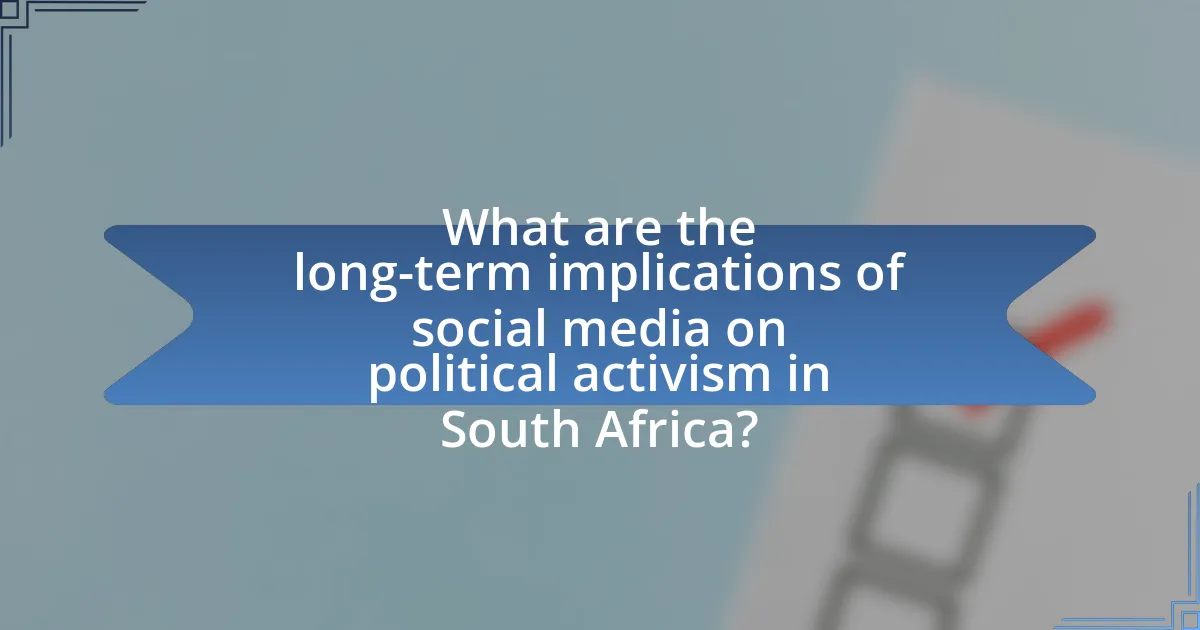
What are the long-term implications of social media on political activism in South Africa?
The long-term implications of social media on political activism in South Africa include increased mobilization, enhanced visibility of issues, and the potential for misinformation. Social media platforms facilitate rapid organization of protests, as seen during the Fees Must Fall movement, where students utilized Twitter and Facebook to coordinate actions against tuition hikes. This digital mobilization leads to greater public engagement and awareness of social issues, evidenced by the rise in online petitions and campaigns addressing inequality and corruption. However, the spread of misinformation can undermine trust in movements, as false narratives can proliferate quickly, impacting public perception and activism effectiveness.
How has social media changed the way future generations engage in political activism?
Social media has transformed how future generations engage in political activism by providing instant access to information and facilitating widespread communication. Platforms like Twitter and Facebook enable activists to mobilize quickly, share real-time updates, and organize events, significantly increasing participation rates. For instance, the #FeesMustFall movement in South Africa utilized social media to coordinate protests and raise awareness about educational funding issues, demonstrating its effectiveness in rallying support and influencing policy discussions. This shift towards digital activism allows for greater inclusivity and engagement, as individuals can participate from anywhere, breaking down geographical barriers that previously limited activism.
What lessons can be learned from past social media-driven protests?
Past social media-driven protests demonstrate the importance of rapid mobilization and the ability to reach a wide audience quickly. For instance, the #FeesMustFall movement in South Africa utilized platforms like Twitter and Facebook to organize protests against rising tuition fees, resulting in significant student mobilization and national attention. Additionally, these protests highlight the necessity of clear messaging; effective communication can galvanize support and clarify objectives, as seen in the Arab Spring, where social media was pivotal in spreading information and coordinating actions. Furthermore, the role of social media in shaping narratives underscores the potential for misinformation to spread, necessitating critical media literacy among participants to discern credible sources. These lessons emphasize the dual-edged nature of social media as both a tool for empowerment and a platform for potential misinformation.
How might social media evolve in its role within political movements?
Social media is likely to evolve into a more sophisticated tool for political movements by enhancing real-time communication and mobilization capabilities. As platforms integrate advanced technologies like artificial intelligence and machine learning, they will enable more targeted outreach and engagement strategies, allowing movements to connect with specific demographics more effectively. For instance, during the 2021 South African protests, social media played a crucial role in organizing demonstrations and disseminating information rapidly, illustrating its potential for future political activism. Additionally, the rise of decentralized platforms may provide greater security and privacy for activists, further empowering grassroots movements.
What best practices should activists follow when using social media for protests?
Activists should prioritize clear messaging and strategic engagement when using social media for protests. Clear messaging ensures that the purpose and goals of the protest are easily understood, which can increase participation and support. For instance, using concise hashtags can help unify the message and make it more shareable, as seen in the #FeesMustFall movement in South Africa, which effectively mobilized students against tuition increases.
Additionally, activists should engage with their audience by responding to comments and sharing updates, which fosters community and encourages more people to join the cause. Research indicates that social media engagement can significantly enhance the visibility and impact of protests, as demonstrated by the Arab Spring, where online platforms played a crucial role in organizing and spreading awareness.
Furthermore, activists must be mindful of privacy and security, using encrypted messaging apps for sensitive discussions to protect themselves from potential surveillance or backlash. This approach is vital in contexts where government repression is a concern, as highlighted by various human rights organizations.
By adhering to these best practices, activists can effectively leverage social media to amplify their protests and drive meaningful change.
How can activists ensure their messages are effectively communicated online?
Activists can ensure their messages are effectively communicated online by utilizing clear, concise language and engaging visuals. Research indicates that posts with images receive 94% more views than those without, highlighting the importance of visual content in capturing attention. Additionally, activists should leverage popular social media platforms to reach broader audiences, as 54% of social media users utilize these platforms for news and information. Consistent messaging across various channels reinforces the core message, making it more memorable and impactful. Engaging with followers through comments and shares fosters community and encourages further dissemination of the message.
What tools and resources are available to enhance social media activism?
Tools and resources available to enhance social media activism include platforms like Twitter, Facebook, and Instagram, which facilitate rapid information dissemination and community engagement. These platforms provide features such as hashtags, live streaming, and event creation that mobilize supporters and raise awareness about social issues. Additionally, graphic design tools like Canva and video editing software such as Adobe Premiere Pro enable activists to create compelling visual content that captures attention. Research indicates that social media campaigns can significantly increase participation in protests; for example, the #FeesMustFall movement in South Africa utilized these tools to organize and amplify student voices, resulting in widespread national attention and policy discussions.
